Taken from emedicine: (revise boundaries with snells)
Introduction to skull base anatomy:
The skull base forms the floor of the cranial cavity and separates the brain from other facial structures. This anatomic region is complex and poses surgical challenges for otolaryngologists and neurosurgeons alike. Working knowledge of the normal and variant anatomy of the skull base is essential for effective surgical treatment of disease in this area.
The 5 bones that make up the skull base are:
- ethmoid bone
- sphenoid bone
- occipital bone
- temporal bone
- petrous portion
- paired frontal bones
- paired parietal bones
Bones forming palate:
- Palatine bone
- Maxilla bone

The skull base can be subdivided into 3 regions:
- anterior cranial fossa
- accommodates the anterior lobe of brain (or frontal lobes, left and right)
- Formed by:
- orbital plate of the frontal bone
- cribiform plate of ethmoid bone
- lesser wings of the sphenoid bone
- Boundaries:
- Anteriorly: posterior wall of frontal sinus
- Posteriorly: roof of splenoid sinus
- Laterally: frontal bone (paired, both sides)
- Centrally: eithmoid bone
- In the center of this region is the cribriform plate, through which the olfactory tracts pass
- If cribriform plate is injured, then there will be loss of sensation of smell
- middle cranial fossa
- The petro-occipital fissure subdivides the middle cranial fossa into 1 central component and 2 lateral components
- contain the 2 temporal lobes of brain
- Boundaries:
- Anteriorly: Greater wing of sphenoid bone
- Posteriorly: superior borders of petrous part of temporal
- Laterally: squamous part of temporal and some part if parietal and greater wings of sphenoid
- Centrally: sella tursica (or sella turcica) of body of sphenoid
- posterior cranial fossa
- accommodates the occipital lobes of the brain
- Boundaries:
- Anteriorly: superior border of the petrous part of temporal bone
- Posteriorly: lesser part of the occipital squama
- Laterally: Temporal & parietal bone
- Floor: Occipital bone
- Centrally: Foramen magnum
The anterior cranial fossa is separated from the middle cranial fossa by the lesser wing of the sphenoid, and the middle cranial fossa is separated from the posterior cranial fossa by the petrous part of the temporal bone.
——–
Extra reading (Taken from Snell’s):
Anterior Cranial Fossa
The anterior cranial fossa lodges the frontal lobes of the cerebral hemispheres. It is bounded anteriorly by the inner surface of the frontal bone, and in the midline is a crest for the attachment of the falx cerebri. Its posterior boundary is the sharp lesser wing of the sphenoid, which articulates laterally with the frontal bone and meets the anteroinferior angle of the parietal bone, or the pterion. The medial end of the lesser wing of the sphenoid forms the anterior clinoid process on each side, which gives attachment to the tentorium cerebelli. The median part of the anterior cranial fossa is limited posteriorly by the groove for the optic chiasma.
The floor of the fossa is formed by the ridged orbital plates of the frontal bone laterally and by the cribriform plate of the ethmoid medially (Fig. 11-6). The crista galli is a sharp upward projection of the ethmoid bone in the midline for the attachment of the falx cerebri. Alongside the crista galli is a narrow slit in the cribriform plate for the passage of the anterior ethmoidal nerve into the nasal cavity. The upper surface of the cribriform plate supports the olfactory bulbs, and the small perforations in the cribriform plate are for the olfactory nerves.
Middle Cranial Fossa
The middle cranial fossa consists of a small median part and expanded lateral parts (Fig. 11-6). The median raised part is formed by the body of the sphenoid, and the expanded lateral parts form concavities on either side, which lodge the temporal lobes of the cerebral hemispheres.
It is bounded anteriorly by the lesser wings of the sphenoid and posteriorly by the superior borders of the petrous parts of the temporal bones. Laterally lie the squamous parts of the temporal bones, the greater wings of the sphenoid, and the parietal bones.
The floor of each lateral part of the middle cranial fossa is formed by the greater wing of the sphenoid and the squamous and petrous parts of the temporal bone.
The sphenoid bone resembles a bat having a centrally placed body with greater and lesser wings that are outstretched on each side. The body of the sphenoid contains the sphenoid air sinuses, which are lined with mucous membrane and communicate with the nasal cavity; they serve as voice resonators.
Anteriorly, the optic canal transmits the optic nerve and the ophthalmic artery, a branch of the internal carotid artery, to the orbit. The superior orbital fissure, which is a slitlike opening between the lesser and greater wings of the sphenoid, transmits the lacrimal, frontal, trochlear, oculomotor, nasociliary, and abducent nerves, together with the superior ophthalmic vein. The sphenoparietal venous sinus runs medially along the posterior border of the lesser wing of the sphenoid and drains into the cavernous sinus.
The foramen rotundum, which is situated behind the medial end of the superior orbital fissure, perforates the greater wing of the sphenoid and transmits the maxillary nerve from the trigeminal ganglion to the pterygopalatine fossa.
The foramen ovale lies posterolateral to the foramen rotundum (Fig. 11-6). It perforates the greater wing of the sphenoid and transmits the large sensory root and small motor root of the mandibular nerve to the infratemporal fossa; the lesser petrosal nerve also passes through it.
The small foramen spinosum lies posterolateral to the foramen ovale and also perforates the greater wing of the sphenoid. The foramen transmits the middle meningeal artery from the infratemporal fossa (see page 750) into the cranial cavity. The artery then runs forward and laterally in a groove on the upper surface of the squamous part of the temporal bone and the greater wing of the sphenoid (Fig. 11-20). After a short distance, the artery divides into anterior and posterior branches. The anterior branch passes forward and upward to the anteroinferior angle of the parietal bone (Fig. 11-131A). Here, the bone is deeply grooved or tunneled by the artery for a short distance before it runs backward and upward on the parietal bone. It is at this site that the artery may be damaged after a blow to the side of the head. The posterior branch passes backward and upward across the squamous part of the temporal bone to reach the parietal bone.
The large and irregularly shaped foramen lacerum lies between the apex of the petrous part of the temporal bone and the sphenoid bone (Fig. 11-6). The inferior opening of the foramen lacerum in life is filled by cartilage and fibrous tissue, and only small blood vessels pass through this tissue from the cranial cavity to the neck.
The carotid canal opens into the side of the foramen lacerum above the closed inferior opening. The internal carotid artery enters the foramen through the carotid canal and immediately turns upward to reach the side of the body of the sphenoid bone. Here, the artery turns forward in the cavernous sinus to reach the region of the anterior clinoid process. At this point, the internal carotid artery turns vertically upward, medial (Fig. 11-20) to the anterior clinoid process, and emerges from the cavernous sinus (see page 750).
Lateral to the foramen lacerum is an impression on the apex of the petrous part of the temporal bone for the trigeminal ganglion. On the anterior surface of the petrous bone are two grooves for nerves; the largest medial groove is for the greater petrosal nerve, a branch of the facial nerve; the smaller lateral groove is for the lesser petrosal nerve, a branch of the tympanic plexus. The greater petrosal nerve enters the foramen lacerum deep to the trigeminal ganglion and joins the deep petrosal nerve (sympathetic fibers from around the internal carotid artery), to form the nerve of the pterygoid canal. The lesser petrosal nerve passes forward to the foramen ovale.
The abducent nerve bends sharply forward across the apex of the petrous bone, medial to the trigeminal ganglion. Here, it leaves the posterior cranial fossa and enters the cavernous sinus.
The arcuate eminence is a rounded eminence found on the anterior surface of the petrous bone and is caused by the underlying superior semicircular canal.
The tegmen tympani, a thin plate of bone, is a forward extension of the petrous part of the temporal bone and adjoins the squamous part of the bone (Fig. 11-6). From behind forward, it forms the roof of the mastoid antrum, the tympanic cavity, and the auditory tube. This thin plate of bone is the only major barrier that separates infection in the tympanic cavity from the temporal lobe of the cerebral hemisphere (Fig. 11-30).
The median part of the middle cranial fossa is formed by the body of the sphenoid bone (Fig. 11-6). In front is the sulcus chiasmatis, which is related to the optic chiasma and leads laterally to the optic canal on each side. Posterior to the sulcus is an elevation, the tuberculum sellae. Behind the elevation is a deep depression, the sella turcica, which lodges the pituitary gland. The sella turcica is bounded posteriorly by a square plate of bone called the dorsum sellae. The superior angles of the dorsum sellae have two tubercles, called the posterior clinoid processes, which give attachment to the fixed margin of the tentorium cerebelli.
The cavernous sinus is directly related to the side of the body of the sphenoid (Figs. 11-9 and 11-10). It carries in its lateral wall the third and fourth cranial nerves and the ophthalmic and maxillary divisions of the fifth cranial nerve (Fig. 11-12). The internal carotid artery and the sixth cranial nerve pass forward through the sinus.
Posterior Cranial Fossa
The posterior cranial fossa is deep and lodges the parts of the hindbrain, namely, the cerebellum, pons, and medulla oblongata. Anteriorly the fossa is bounded by the superior border of the petrous part of the temporal bone, and posteriorly it is bounded by the internal surface of the squamous part of the occipital bone (Fig. 11-6). The floor of the posterior fossa is formed by the basilar, condylar, and squamous parts of the occipital bone and the mastoid part of the temporal bone.
The roof of the fossa is formed by a fold of dura, the tentorium cerebelli, which intervenes between the cerebellum below and the occipital lobes of the cerebral hemispheres above (Fig. 11-10).
The foramen magnum occupies the central area of the floor and transmits the medulla oblongata and its surrounding meninges, the ascending spinal parts of the accessory nerves, and the two vertebral arteries.
The hypoglossal canal is situated above the anterolateral boundary of the foramen magnum (Fig. 11-6) and transmits the hypoglossal nerve.
The jugular foramen lies between the lower border of the petrous part of the temporal bone and the condylar part of the occipital bone. It transmits the following structures from before backward: the inferior petrosal sinus; the 9th, 10th, and 11th cranial nerves; and the large sigmoid sinus. The inferior petrosal sinus descends in the groove on the lower border of the petrous part of the temporal bone to reach the foramen. The sigmoid sinus turns down through the foramen to become the internal jugular vein.
The internal acoustic meatus pierces the posterior surface of the petrous part of the temporal bone. It transmits the vestibulocochlear nerve and the motor and sensory roots of the facial nerve.
The internal occipital crest runs upward in the midline posteriorly from the foramen magnum to the internal occipital protuberance; to it is attached the small falx cerebelli over the occipital sinus.
On each side of the internal occipital protuberance is a wide groove for the transverse sinus (Fig. 11-6). This groove sweeps around on either side, on the internal surface of the occipital bone, to reach the posteroinferior angle or corner of the parietal bone. The groove now passes onto the mastoid part of the temporal bone, and here the transverse sinus becomes the sigmoid sinus. The superior petrosal sinus runs backward along the upper border of the petrous bone in a narrow groove and drains into the sigmoid sinus. As the sigmoid sinus descends to the jugular foramen, it deeply grooves the back of the petrous bone and the mastoid part of the temporal bone. Here, it lies directly posterior to the mastoid antrum.
_____________________________________________________________________
Cranial nerves
Cranial nerves are nerves that emerge directly from the brain (spinal nerves emerge from segments of the spinal cord). There are 12 pairs of cranial nerves. 1st & 2nd pair are from the cerebrum, the other 10 pairs are from the brainstem.
I – Olfactory nerve
II – Optic nerve
III – Oculomotor nerve
IV – Trochlear nerve
V – Trigeminal nerve
VI – Abducens nerve
VII – Facial nerve
VIII – Vestibulocochlear nerve / Auditory nerve
IX – Glossopharyngeal nerve
X – Vagus nerve
XI – Accessory nerve
XII – Hypoglossal nerve
**all nerves are single paired, except for olfactory nerves (50-60)
Mnemonic: Oh, Oh, Oh, To Touch And Feel Vagina Good Vibe AH
Functions of the cranial nerves:
Some Say Marry Money, But My Brother Says Big Boobs Matter More
S – sensory only
M – motor only
B – both sensory & motor
Origin of the 12 cranial nerves
- Cerebrum
- 1 & 2
- Brainstem
- Midbrain
- 3 & 4
- Pons
- 5, 6, 7, & 8
- Medulla
- 9, 10, 11 & 12
Only Accessory nerve (11th) has dual origin – Cranial & spinal root
Only nerve arise from dorsal aspect – Trochlear nerve (4th)
Innervation of extra–ocular motor muscles:
LR6 (SO4) 3
- Lateral rectus – 6th cranial nerve
- Superior oblique – 4th cranial nerve
- Remaining eyeball movers – 3rd cranial nerve
Foramens of the Cranial Fossae & Structures passing through it
Anterior Cranial Fossa
- Perforations in cribiform plate (mid of ethmoid bone)
- Optic nerve
Middle Cranial Fossa
- Optic Canal (lesser wing of sphenoid bone)
- Optic nerve
- Ophthalmic artery
- Superior orbital fissure (btwn lesser & greater wings of sphenoid bone)
- Lacrimal, frontal, trochlear, oculomotor, nasociliary, and abducent nerves
- superior ophthalmic vein
- Foramen rotundum (greater wing of sphenoid bone)
- Maxillary division of the trigeminal nerve (V2)
- Foramen ovale (greater wing)
- Mandibular division of the trigeminal nerve (V3)
- lesser petrosal nerve
- Foramen spinosum
- middle meningeal artery
- Foramen lacerum (Between petrous part of temporal and sphenoid)
- internal carotid artery
Posterior cranial fossa
- Foramen magnum (occipital bone)
- Medulla oblongata
- spinal cord
- spinal part of accessory nerve (C1-C6)
- right and left vertebral arteries
- anterior & posterior spinal arteries
- alar ligaments
- Hypoglossal canal (occipital bone)
- Hypoglossal nerve
- Jugular foramen (Between petrous part of temporal and condylar part of occipital)
- Glossopharyngeal, vagus, and accessory nerves
- sigmoid sinus becomes internal jugular vein
- Internal acoustic meatus (Petrous part of temporal)
- Vestibulocochlear and facial nerves

_____________________________________________________________
Fractures of the cranial fossa
- Fracture of petrous part of temporal bone
- severe disablity of dorsal function of middle & internal ear
_____________________________________________________________________
Dura mater
- leathery, strong meninx composed of 2 fibrous connective tissues
- 2 layers
- inner/meningeal layer
- outer/endosteal layer
- the 2 layers separate in certain areas and form dural sinuses
- for the passage of venous blood
- Superior sagittal sinus
- if torn, can cause subdural hematoma/hemorrhage
- Inferior sagittal sinus
- 4 dural septa extend inward & limit excessive movement of the brain
- Falx cerebri
- fold that dips into the longitudinal fissure
- separates 2 cerebral hemispheres
- Falx cerebelli
- runs along the vermis of the cerebellum
- separates 2 cerebellar hemispheres
- Tentorium cerebelli
- horizontal dural fold extends into the transverse fissure
- separates temporal love from cerebellum
- Diaphagma sellae
- roof of hypophyseal fossa
- Note the Diploe
- The soft spongy material between the inside table and outside table (the interior and exterior bony plates) of the skull
- Traversed by veins – Emissary vein
Coverings of the brain
- SCALP
- Skin
- SubCutaneous tissue
- Epicranium Aponeurosis
- Loose areolar connective tissue
- dangerous layer of scalp
- infection from superficial fascia is transmitted to this layer & produce abscess
- Pericranium
- Diploe
- Inside cranial cavity
- Endosteal layer of dura mater
- Meningeal layer of dura mater
- Falx cerebri
- Superior sagital sinus
- Arachnoid mater
- Subarachnoid space
- Superficial cerebral artery & vein
- Pia mater
- Falx cerebri
- Inferior sagital sinus
- Extradural space
- Middle meningeal artery & vein
- causes extradural haemorrhage
- Intracranial/on cerebrum
- Superior cerebral vein
Sequence of venous drainage of brain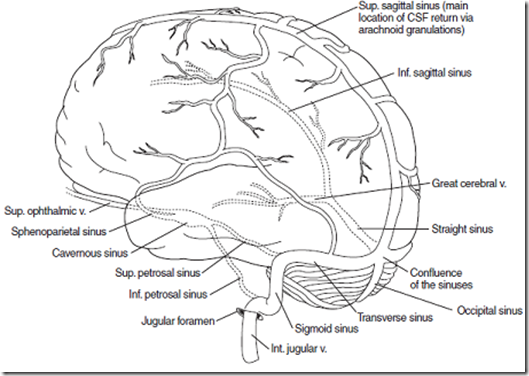
Starts from the right side
Superior cerebral vein pierces the arachnoid, inner dura mater, and drains into the superior sagittal sinus
- Superior sagittal sinus
- Right transverse sinus
- Right sigmoid sinus
- Right internal jugular vein
- Inferior sagittal sinus
- Cerebral vein of Galen joins ISS
- formed by 2 internal cerebral vein
- Straight sinus
- Left transverse sinus
- Left sigmoid sinus
- Left internal jugular vein
- a large collection of thin-walled veins creating a cavity bordered by thetemporal bone of the skulll and the sphenoid bone, lateral to the sella turcica.
- blood-filled space
- Structures passing through this space (OTOM CAT)
- internal carotid artery
- Cranial nerves
- 3 – oculomotor
- 4 – trochlear
- 6 – abducens
- V1 (opthalmic), V2 (maxillary)
- Infection from the face may reach the cavernous sinus through its many anastomotic connections, with severe consequences
- Cavernous sinus thrombosis –
- Ophthalmic nerves
- cause eyelid oedema, periorbital oedema
- exopthalmus
- 3, 4, 6 cranial nerves
- opthalmophegia
- V1, V2
- absent corneal reflex
- caput medusae in the eye
- The cavernous sinus drains by two channels, the superior and inferior petrosal sinuses, ultimately into the internal jugular vein.
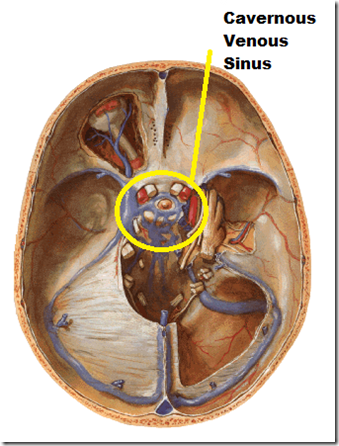
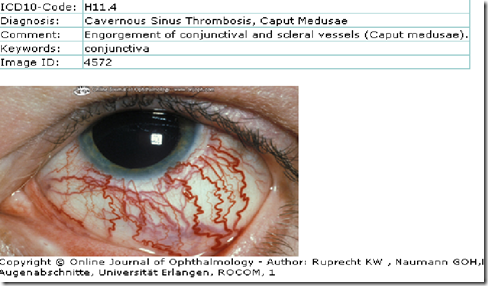
_____________________________________________________________________
Haemorrhage of the brain
Extradural haemorrhage (Artery)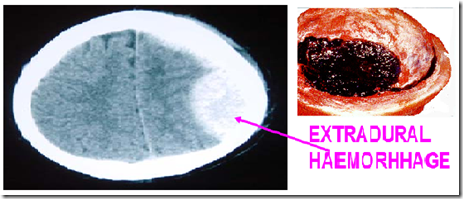
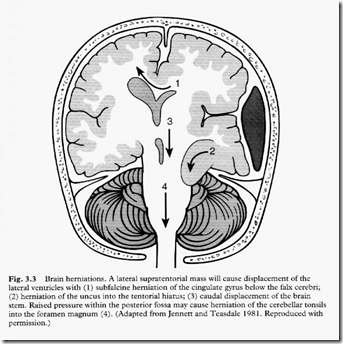
- Usually due to blow to the side of the head
- at the Pterion
- point at which the frontal, parietal, temporal & sphenoid (greater wing) bones are united by H-shaped sutures
- area where skull is thinnest/easiest to fracture
- lies opposite the anterior branch of middle meningeal artery
- Fracture may rupture the anterior branch of middle meningeal artery
- causes collection of blood
- temporal lobe will herniate towards the center of the brain
- compress and push structures to opposite side
- opposite side will have loss of function
- can die within 6 hours
- from tears in bridging veins that cross the subdural space
- due to rapidly changing velocity
- shaken baby syndrome
- Symptoms of subdural hemorrhage have a slower onset than those of epidural hemorrhages because the lower pressure veins bleed more slowly than arteries (in extradural haemorrhage)
- Collected blood from the subdural bleed may draw in water due to osmosis, causing it to expand
- which may compress brain tissue and cause new bleeds by tearing other blood vessels
- The collected blood may even develop its own membrane
- In some subdural bleeds, the arachnoid mater of the meninges is torn, and cerebrospinal fluid (CSF) and blood both expand in the intracranial space, increasing intracranial pressure
- Substances that cause vasoconstriction may be released from the collected material in a subdural hematoma, causing further ischemia under the site by restricting blood flow to the brain
- The body gradually reabsorbs the clot and replaces it with granulation tissue
_________________________________________________________________
Questions:
1) A construction worker suffers from a head trauma from a fall on the job. In the emergency room, a clear sticky fluid emerges through the nostrols. A weeks later, the patient notices that he has lost his appreciation of the smell of food.
What bone may have been fractured to account for these symptoms?
Answer: Ethmoid bone (beneath it, the olfactory nerve)
2) A 26 y/o woman had been always visiting her family physician for frontal headaches, that are resistant to medication. The patient had irregular menstrual cycles and also noted that she was losing her peripheral vision bilaterally. MRI reveals a tumour in the anterior cranial fossa.
What structure might the tumour be compressing?
Answer: Optic nerve (due to pituitary adenoma, near the optic chiasma)

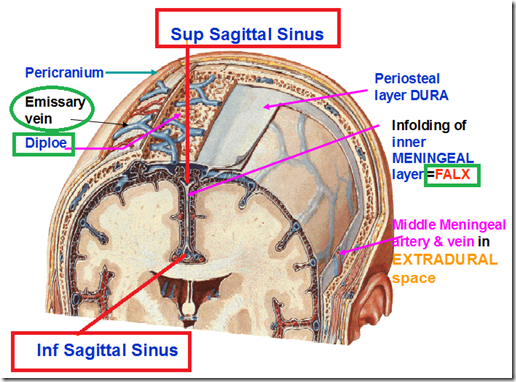
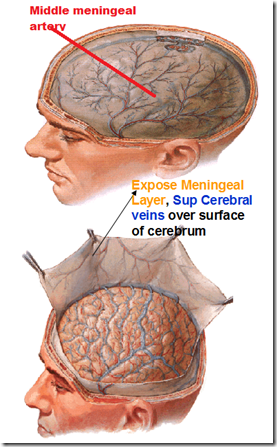
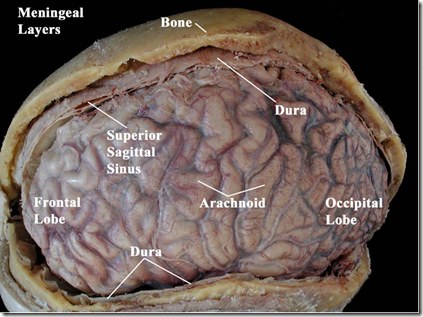
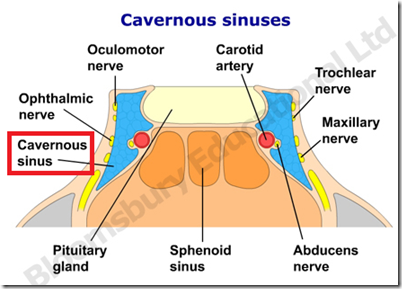
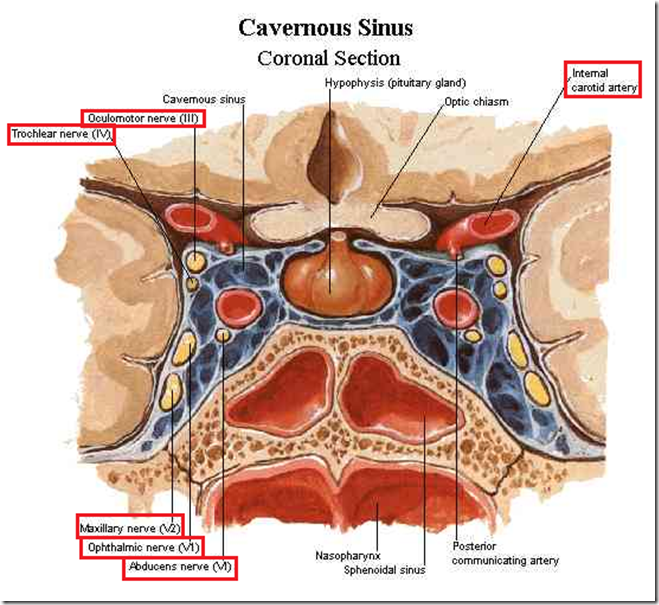
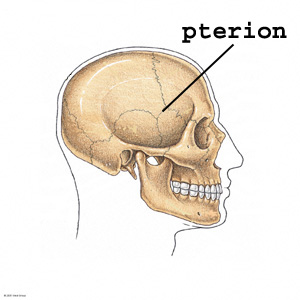

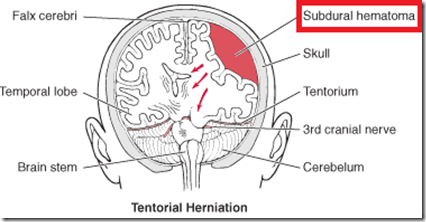
thanx for such a helpful lecture…………………………
🙂 Thanks!
You’re welcome!
Some corrections:
1)
The skull base forms the floor of the cranial cavity and separates the brain from other facial structures.
=> the braiin is not a facial structure, hence you should not say: … separates the brain from OTHER FACIAL STRUCTURES….
2)
anterior cranial fossa
accommodates the anterior lobe of brain
The term anterior lobe is very uncommon and the fossa actually stretches over both sides: use: the frontal lobes (2, left and right)
3) middle cranial fossa
……
Centrally: sella tursica of body of sphenoid
It´s sella turcica (Turkish saddle)
so far for now…
Thank you Michael for the corrections. Certainly valuable to all of us! Best regards, Terri
Detailed precise. Not bad
Good information
nice article very useful. thank u 🙂
What a brilliant post! Well crafted. Thank you for taking the time to do this. A patient of mine had a benign tumor…I am only getting sporadic information thus far, but it seemingly effected his executive function…it appears and often sounds like the tumor was in the same region where Phineas Gage’s injury was. When I spoke to one of his nurses during his last hospital stay…after a seizure, their reply was there is scar tissue behind the beginning of the middle fossa, assuming that would be from the front of the skull. The patient showed the scar from the removal procedure, as it looks about right. Criminal behavior was recorded as early as 1959, then it wasn’t until somewhere around 1991 when he experienced his first grand mal that then prompted attention. Since the tumor was removed and mood- stabilizers/seizure meds introduced…his behavior improved. Just wondering if you had any broad comments about this type of brain issue. My apologies on not yet having additional information. Thank you for your time.
Hi, how is the patient now? I hope things got better since then..
Thank you so much! Very helpful!!!
Greetings, the patient is functioning day to day and since his tumor was removed, some 11 years ago…some of his behavioral symptoms have reduced…however, the tricky part is he also learned behaviors while this tumor was present and well continues to act in a way tat is not conducive to society. At 73 he is living in his own prison and refuses to be enlightened. From a psych view point his energy calibration is low, living in fear and anger…however not sure if he’s capable of feeling shame or guilt. The mood stabilizers have helped, but the diabetes…well sends him into rages at times. he had a major seizure recently while driving a truck full of asphalt! luckily he was waiting for a train and a few cars were in front of him. The truck fortunately just rolled into the back of the car. Also, his long term memory seems to have been greatly disturbed. Which of course can cause disruption in his family life. additionally he was experiencing dental sepsis! This poor family has suffered beyond comprehension. It is upsetting that until I came into the picture, not one doctor counseled the family explaining potential behavioral issues…(a small snap shot of health care in Canada). So he keeps himself occupied daily with work, but lets just say his executive function, well stems from deceit and criminal intent reigns. Even at this age he is a menace to society…he is destroying the wealth of the family. It is really a difficult seat from which to watch. Do you have any comments on the location of the tumor/now scar tissue? Thank you and hope to hear from you soon.
Thank you….atlast it help me a lot in ma presrentation…tnx once again